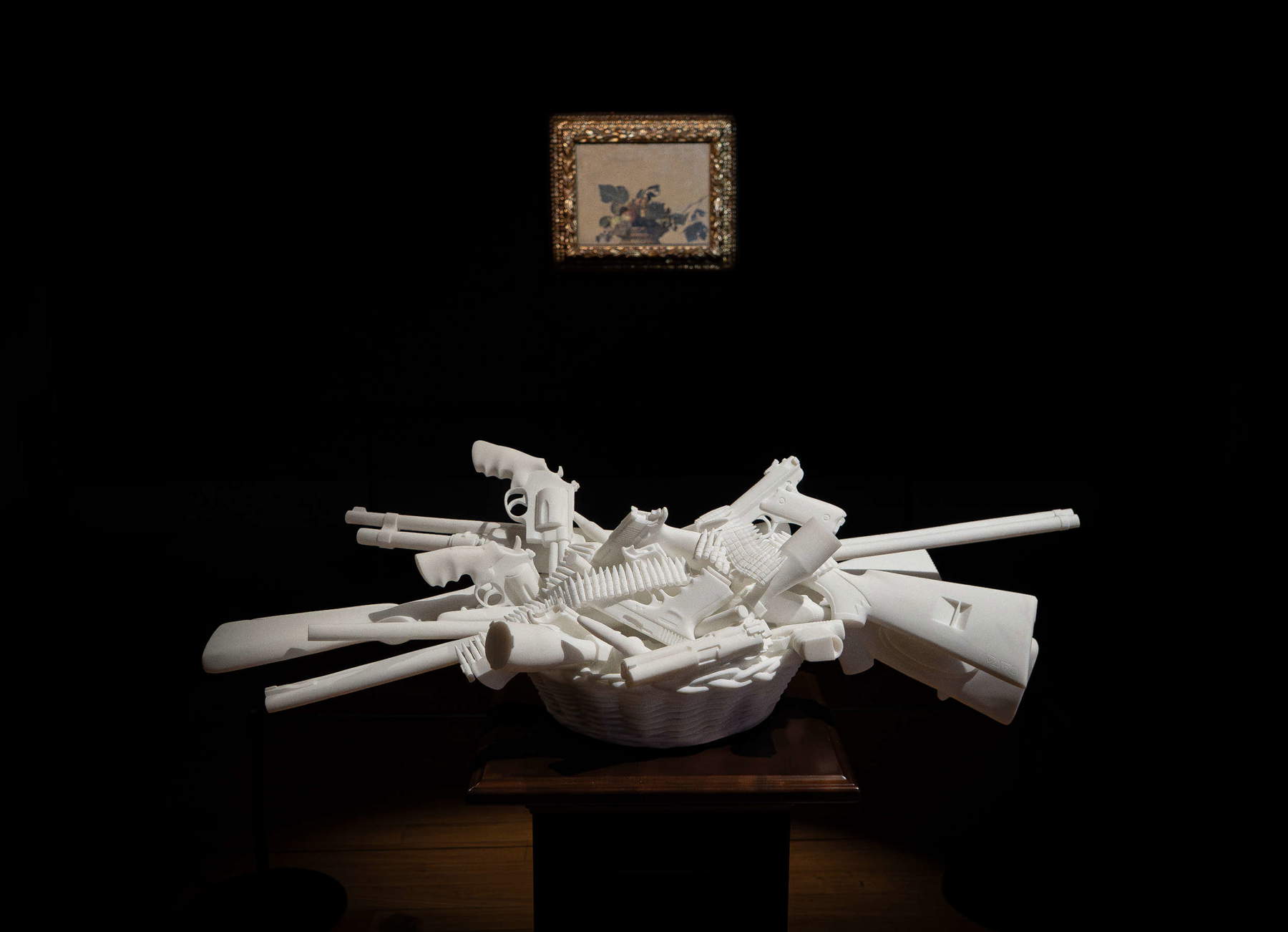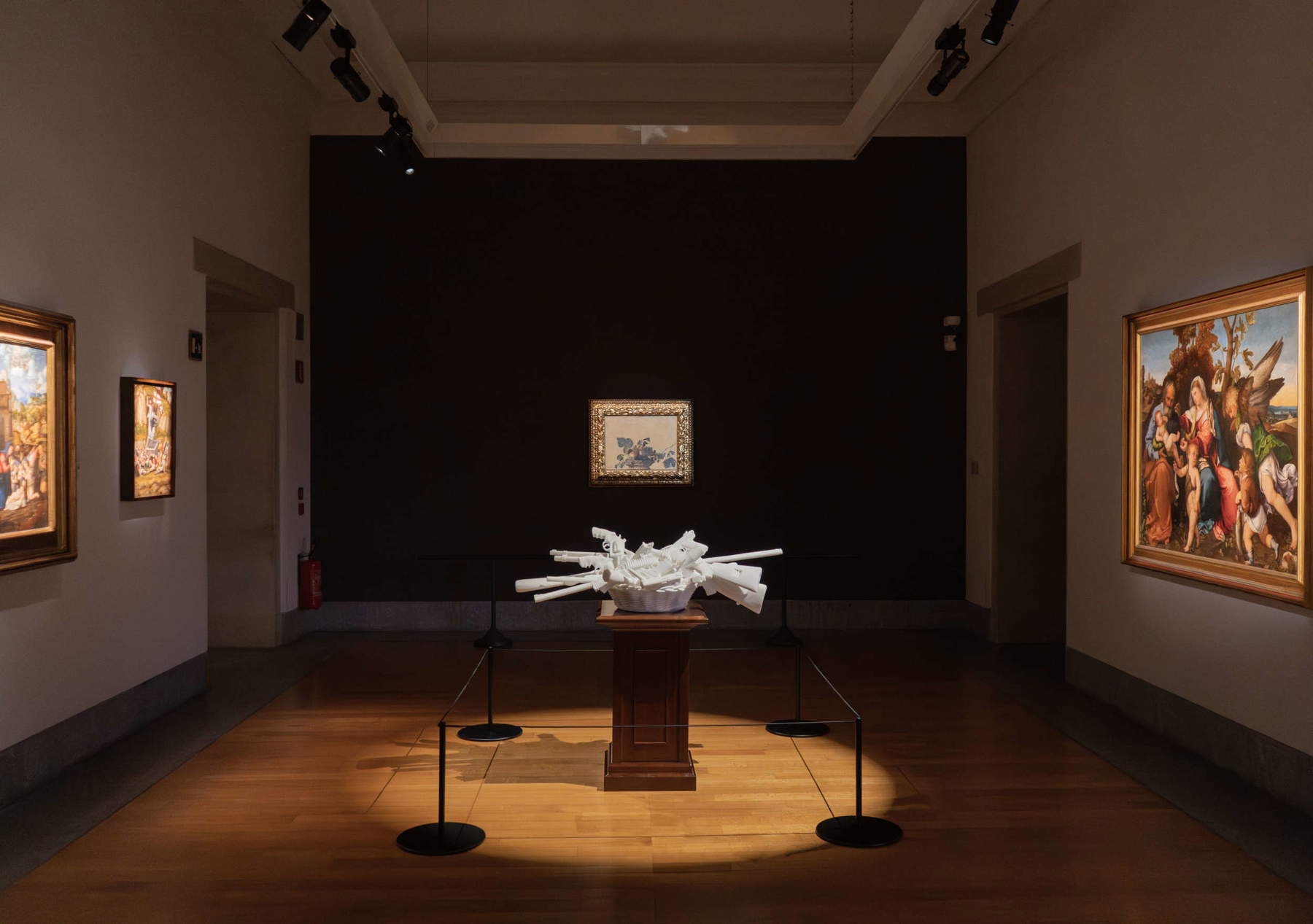I have a hard time believing that the Basket of Fruit on Caravaggio is innocent, especially if its supposed clarity should stand out by contrast when looking at it together with Jago’s Basket of Arms that the Pinacoteca Ambrosiana in Milan has been displaying in front of Merisi’s still life for the past three months. I cannot think of a more ambiguous, more disturbing and even more disturbing composition of leaves and fruit than the Basket. Manganelli said that the characteristic that struck him most about Caravaggio was his cunning, a quality necessary to accomplish a task that was foreign to the society in which he operated and that forced him to have to lie, entice, baffle. Caravaggio’s cunning here lies in conveying to the viewer the idea of a nature that is already decaying when it is in the fullness of its juiciness, in making it clear that deterioration, decay, putrefaction are already here, in our midst, even when appearances suggest otherwise. There is nothing innocent inside that basket.
However, I am not saying anything new, and I realize that it is uninteresting to keep talking about Caravaggio’s Basket , a basket of arms that is supposed to denounce the violence of our society. And it is also uninteresting to talk about the gulf that exists between his canestra and that of Jacopo Cardillo. Perhaps it is of little interest to him as well: the director of the Ambrosiana, Monsignor Alberto Rocca, said that the “event” (as he calls it throughout the interview he was given to present the comparison: at least he used the more correct term) arose from a chance encounter with Jago. And it probably must not have seemed real to him to be able to display one of his works in front of Caravaggio: patience then if the basket full of weapons is a work of such disarming naiveté that it does not require much comment. It is not a work that works on a threshold: it is a work that says it all at once, it is an image that has bargained with our inattention and our need to receive simple answers for complex problems, has realized that it is devoid of any bargaining power and has therefore decided to show itself in its barest rhetoric. It could be, if anything, the work of a valid illustrator, of a cartoonist who needs to immediately capture the reader of a newspaper with a sarcastic comment on the fact of the day (or week or even year) and consequently needs to be explicit and didactic to make himself understood.


Jago is probably right, however: all of his art is a repertoire of images that have the enormous merit of engaging crowds. And this is no small merit: if the visual arts are increasingly irrelevant to the non-expert audience, Jago is at least among the few who ask themselves the problem, and it is not denied that for many it can be a source of initial interest, it can be a first gateway. It will, however, be repetitive: on the sidereal distance that separates it from the orientations of art criticism (or, rather, from what little is left of it) there is not much to say, just as there is little to say about why, on the contrary, Jago’s works manage so easily to capture the interest of the public and, sometimes, even that of some institutions. The essence of Jago’s art is all in the storytelling. It has already been discussed on these pages and elsewhere: Jacopo Cardillo is a successful artist because his sculptures are easy to understand, they aim to arouse emotions about the issues of the moment, they address their topics in a direct, illustrative way, without digging. Conversely, they can be said to be superficial, to lack tension, to be unchallenging, to seek consensus rather than ambiguity or depth, but his audience would respond with a thunderous “e sticazzi” to the critic’s address with a raised finger, and they would also do well. Jago is evidently well aware that in the age of disintermediation, infodemics, and collapsing attention spans, a work of art is all the more effective the more able it is to reach immediately those who scroll through images and videos on a phone screen (because this is now the way the bulk of people know art: not live, but through social, and it is no coincidence that Jago is the most followed Italian visual artist on Instagram). And patience if his works seem more gimmicks and boutades than works moved by sincere authenticity (inevitable to think, for example, of the female version of Michelangelo’s David that Jago took around the world with the Vespucci ship tour: an apparently provocative operation, but in reality devoid of any conceptual development, lacking any solid support, and therefore extremely poor, the child of a more media than artistic approach). Give Jago what is Jago’s: namely, numbers, audience success, commercial success, and assessors ready to roll out red, burgundy, purple carpets of all colors to him.
So far, however, so good: the public has the full faculty of recognizing itself in the art it considers closest to itself, and if someone thinks that the David with the mulieval sexual attributes is closer to and conforms to his own taste and thinking, no one can say anything to him. Everyone has the right to get excited as and as much as he wants, everyone has the right to turn on whatever he wants, and certainly Cardillo is not denied the ability to strike a chord with his audience. It is entirely legitimate.
Some perplexity should circulate, however, at least among insiders, if the legitimacy comes from a museum that also happens to have a Caravaggio in its collection. Having dispelled any reasonable doubt as to whether the Caravaggio-Jago exhibition might be a clever provocation to slap the public and insiders in the face and nail the entire audience to all the problems and all the ’irrelevance of contemporary art (in the case it would border on genius, but I don’t think that was the museum’s intent, and even if it were no one perceived it as such), the real point of the issue is not so much the confrontation itself. The point is another, and it is more about the role of the museum than the mere happening. It is more about the general than the particular. In a nutshell: there is a museum among the most important in Italy that finds it interesting to mount an exhibition all based on the juxtaposition of a work by Caravaggio and a work by Jago, which it mistakes for “bold denunciation” a work that, in front of the Basket of Fruit, stands out, if anything, for predictability and moralism, and that takes seriously an artist who claims to have “wanted to investigate the silent violence that permeates our society” with a basket of revolvers and shotguns.
So, if one believes that the museum is still a place that serves to give order to the past and the present, it is legitimate to cultivate some slight doubts about the solidity, the tightness, the necessity and even the very grounding of the operation. In other words: if one believes that the “two gazes on the transience of life,” as per the title of the exhibition, of Caravaggio and Jago are comparable, that the two can play on the same field, that there is not a thread of populism and superficiality in the idea of believing that Jago can establish a dialogue with Caravaggio by presenting a basket with pistols and rifles, then it is more than legitimate to ask oneself some questions. If, on the other hand, one bets on the fastest horse to attract audiences to the museum, especially if the museum is perceived to be distant from all those audiences who are prone to ecstasy on half an Instagram in front of Jago’s marbles, then one may as well divest oneself of the shoes of confrontation between past and present, one may abandon cultural alibis, one may avoid rhetoric about denouncing violence, and it might instead be more profitable to present the comparison, for example, with the phrasing of wrestling matches. Something like “the cursed painter versus the Michelangelo of the third millennium, the mysterious silence of Caravaggio and the sculpted fist of Jago in an unprecedented confrontation.” After all, years ago Cristiana Collu organized a beauty contest among nineteenth-century portraits, and in more recent times Caravaggio’s Bacchus was exhibited at Vinitaly, so we are already quite used to it.
Warning: the translation into English of the original Italian article was created using automatic tools. We undertake to review all articles, but we do not guarantee the total absence of inaccuracies in the translation due to the program. You can find the original by clicking on the ITA button. If you find any mistake,please contact us.